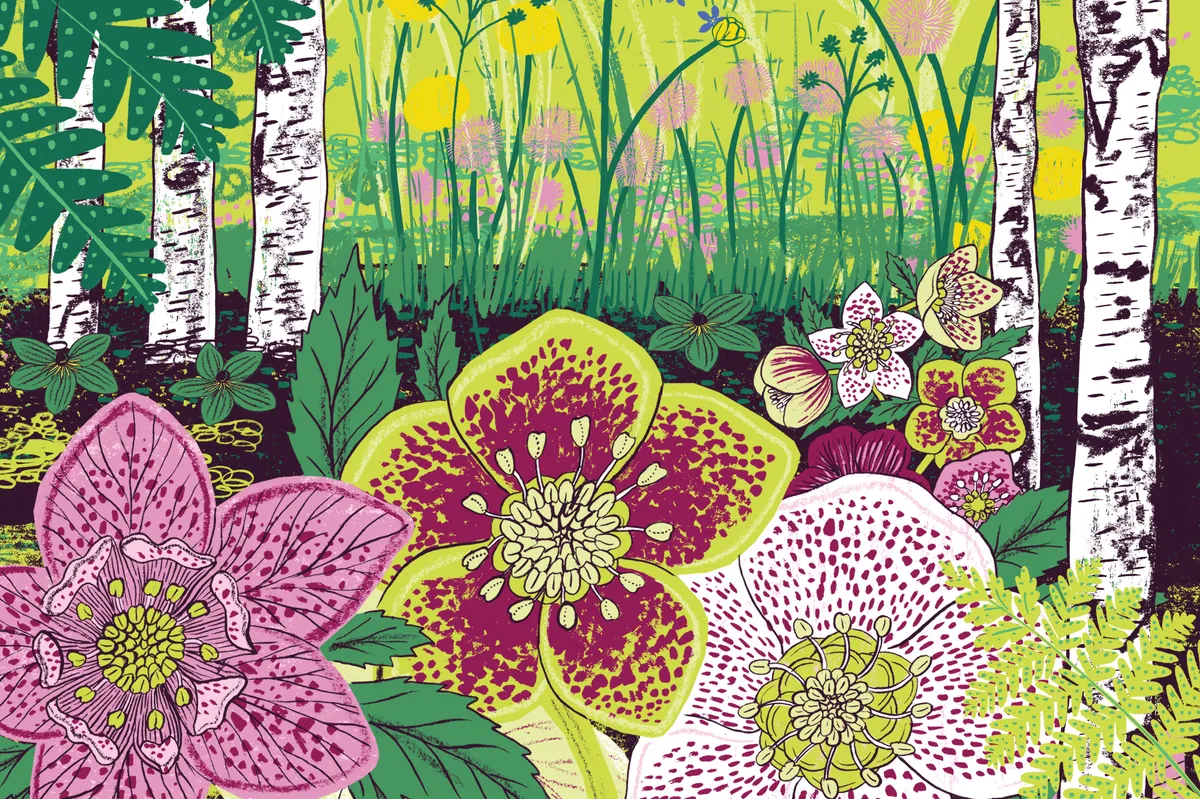The Pyrenees’ highest peaks and most spectacular scenery are found in France, in the central region around the Cirque de Gavarnie – a rock ampitheatre sculpted by glaciation, although the glaciers themselves have all but disappeared. Here the steep, V-shaped valleys that lead from the great peaks are lined with mountain pines (Pinus mugo) and birch. The woods, wetlands and grasslands are full of flowers; a convergence of northern and southern European species. Traditional farming methods encourage species diversity (the best hay meadows I found were around 1,200m). I visited the Parc National des Pyrénées, a protected, largely uninhabited area with more than 3,000 species of plant. The altitudinal range and geological composition have created a great diversity of habitats.
In need of clean mountain air, I had only five days for a botanical trip. The easy rural charm and accessible treks of the mountains in early summer are an antidote to the pressures of work. Start out as the snow melts and you’ll be spoilt for choice both in the range and extent of your trekking routes and in the plant communities to explore.

When to go
Between April and late October, with flowers peaking in May-June and July at higher elevations. Be aware that popular routes can be very crowded in July and August, although some passes only become accessible during these months.
Where to go
I arrived early in Gavarnie and quietly explored woodland, sub montane meadows and alpine flora. The valley descends from an incredible natural ampitheatre of cliffs and waterfalls. Wandering off the main route and through wooded areas, I found a jungle of ferns, meadow rue, the marsh spurge Euphorbia palustris, geraniums and clumps of hellebores with their great bloated seedheads. Then the unmistakable wide leaves of Paris quadrifolia. In grazed clearings Gentiana verna puncture the grass floor with vivid shots of Klein Blue. The gentle lavender pompoms of Globularia nudicaulis, martagon lilies, and mountain globeflower (Trollius europaeus) thrive in the ungrazed meadows. Iris latifolia were yet to flower.
Up in the cirque opportunistic alpine flowers appear in the limestone scree as the snow recedes. Clambering across the snowfields I found colonies of brilliant white Hepatica nobilisand – once I got my eye in – the tiny fringed alpine bonnets of Soldanella alpina. Look up and see the Grande Cascade de Gavarnie (at 440m Europe’s highest waterfall), thundering into the glacial basin.
I reached the Spanish border at Port de Gavarnie (2,270m). When the track ends continuing on foot rewarded me with vast, pale swathes of the endemic Ranunculus pyrenaeus. Flashes of deep blue run through these, thanks to another limestone-loving gentianGentiana occidentalis, its decorative trumpets opening in the sun. I was keen to study different habitats, and found just that in a paradisiacal valley leading from the Lac du Tech in the Val d’Azun. I headed up towards Lac d’Ausseilla (2,192m) and wandered through drifts of crimson-flowered alpine rose (Rhododendron ferrugineum). A river formed by springs and converging streams soaks the valley floor creating a bright floral swamp. It was a floating garden of sunshine yellow Caltha palustris, insectivorous Drosera, Pinguicula grandifloraand the Alpine marsh orchid Dactylorhiza majalis.
Plant to grow at home
The perennial horned pansy, Viola cornuta, has distinctive, long, tapering spurs, an ebullient habit and plentiful sweet-smelling, pale-violet flowers that last throughout spring and early summer. It is endemic to the Pyrenees, abundant in the montane pastures found between 1,000-2,300m. Jostling for space alongside bladderwort, buttercups, bistort, Campanula glomerata and masses of European yellow rattle, Viola cornuta holds the whole composition of these rich hay meadows together, tumbling through the stems of taller neighbours. In cultivation it will return for a second autumn flush of flowers if you cut it back and water to encourage regrowth. The foliage, a mass of small, rich-green leaves, is evergreen making it effective and attractive groundcover that reaches 15cm.
Also in cultivation is Viola cornuta Alba Group, with crisp white flowers. This complements green foliage plants and can be very useful in bringing light to a shady spot. Tolerant of full sun, partial shade and also of exposure, V. cornuta needs fertile, moist soil and good drainage. Remembering that they are from one of the wettest regions in France, it is worth adding humus to your ground to get young plants established, dividing established clumps in spring or autumn.
Guides and maps
- Fleurs des Pyrénées faciles à reconnaître by Philippe Mayoux (Rando Editions, 2013). Not available in translation.
- Flowers of South-west Europe: A Field Guide by Oleg Polunin and BE Smythies (Oxford, 1988).
- Trekking in the Pyrenees by Douglas Streatfeild-James (Trailblazer, 1998).
Places to stay
Camping Mialanne
63 Route d’Azun, 65400 Arrens-Marsous, France. Tel +33 (0)5 6292 6714/6237 9608, campingmialanne.fr
A campsite with good facilities and a great position. It’s near the picturesque town of Argelès-Gazost, which has a lively Tuesday market, where I stockpiled local cheeses for my picnic lunches.
Le Jardin des Bain (lejardindesbains.com),
A thermal day spa where I eased tired limbs.
If you prefer a little more comfort than that offered by camping there are plenty of wonderful rural gîtes in the Pyrenees (en.gites-de-france.com).
Words Hannah Gardner
Illustration Alice Pattullo
This article was taken from the May issue of Gardens Illustrated (260). Hannah's series on botanical travels can be found in each issue of the magazine.
